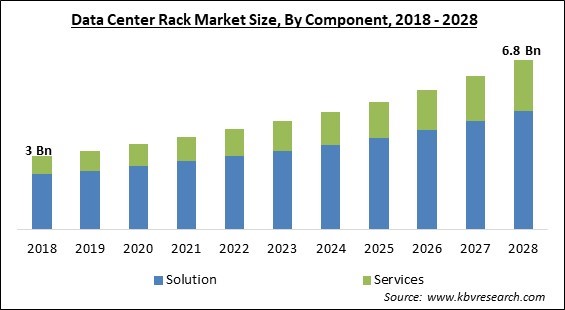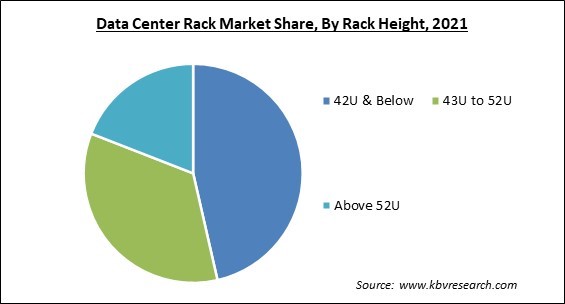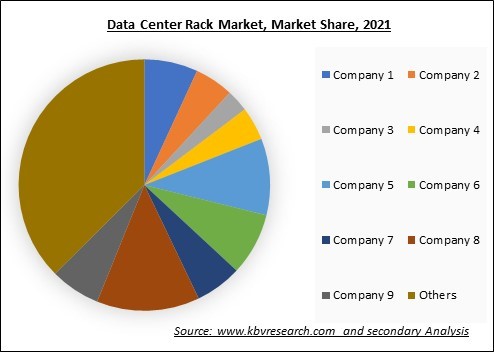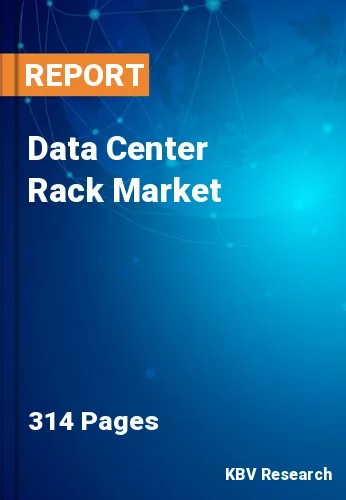The Global Data Center Rack Market size is expected to reach $6.8 billion by 2028, rising at a market growth of 9.2% CAGR during the forecast period.
A physical structure in the shape of a data center rack is typically built of steel and other alloys. It stores electronic servers, networking hardware, cooling systems, and other computer equipment in data centers. These racks give the devices enough room and airflow so temperature swings won't harm them, and they also keep cords, wires, and other pricey components from getting tangled.

Three to four mounting rails are the essential components of a level rack, and a supporting structure holds the rails firmly in place. Then, according to their capacity or the amount of equipment they can contain, each shelf is carefully constructed with slots for attaching electrical, internet, and networking connections. The market is expanding primarily due to the increased popularity of big data analytics and the modernization of IT infrastructure.
The administration of intricate and disorganized organizational data that is handled across numerous data centers is aided by big data analytics. As a result, the need for data centers is expanding, increasing the need for the racks needed to store various networking and IT equipment. Additionally, the requirement to store the data produced by smart homes, towns, and grids, which necessitates systems with broader racks and improved designs, is enhancing the use of data center racks.
The development of low-cost rack solutions with features like corrosion resistance, thermal management, system expandability, and compatibility with different organizational verticals is another reason for boosting the adoption rates of these racks. Additionally, the market has tremendous prospects for growth due to the rising investments in data center equipment worldwide.
The COVID-19 pandemic has benefited the data center rack industry growth because data center rack technologies are assisting businesses in meeting the high capacity need for data storage. As data storage increases, there is an increasing need to ensure the data center rack service provider has the power and ability to supply data center rack solutions with excellent performance. Because of this, service providers like local data center operators and providers are investing a lot in data center racks for various use cases. Additionally, the COVID-19 pandemic presents an opportunity for the data center rack market forecast since businesses all over the world are implementing data center racks to support work-from-home initiatives and enable their business goals.
Data center rack can make use of AI's predictive analytics skills to discover security device capability that is diminishing. This enables security teams to address any issues before they become serious and endanger a data center. Businesses that integrate AI into their data center network can improve their ability to automate common network tasks, increase security, and spot cyber risks based on behavioral changes. More solutions are required due to the data center racks' rapid expansion in order to guarantee their security. These new trends can help to ensure their protection going forward and can also contribute to the development of an organization-wide security system culture.
Governments all over the world are investing more & more in building hyper-scale data center infrastructure to fulfill the growth in consumer and commercial demand for digital services. The need for hyper-scale data centers for storage is brought on by the increased adoption of cutting-edge technologies like AI, IoT, and ML across numerous industries. Therefore, rising investments in building hyper-scale data centers are what is driving the market for data center racks.
Blade systems can pack a lot of computing power into a small area with up to 84 servers in a rack. When an Enterprise Storage System such as Network Attached Storage (NAS) or a Storage Area Network is required, blade servers are typically deployed (SAN). By offering the maximum processor per RU availability, they maximize the space that is available. Thus, the market growth for data center racks would be hampered by the increasing use of blade servers.
Based on component, the data center rack market is segmented into solution and service. In 2021, the solution segment held the highest revenue share in the data center rack market. Datacenter (DC) administrators and IT specialists need the appropriate configurations and tools to suit the needs of their unique environments, as well as remote management solutions that let them easily and rapidly access servers, network devices, and other mission-critical tools. These items are not only necessary for the system to function properly; they can also contribute to a larger strategy that lowers costs for the business.

Based on rack type, the data center rack market is segmented into cabinets/enclosed racks and open frame. In 2021, the cabinet/enclosed racks segment witnessed the largest revenue share in the data center racks market. The adoption of cutting-edge technologies and the increasing demand for the cabinet platform is projected to accelerate category expansion. To encourage market expansion, the key players also concentrate on the creation of cabinet platforms and digital infrastructure. The electric and digital infrastructure construction specialist's adaptable, durable, and secure product is made to house devices.
Based on rack height, the data center rack market is segmented into 42U & below, 43U up to 52U, and above 52U. In 2021, the 43U to 52U segment garnered a significant revenue share in the data center racks market. Due to organizations' increasing need for additional space, rack sizes have increased to accommodate more racks. The utilization of 48U racks is predicted to fuel the expansion of this segment. Additionally, 45U racks are predicted to significantly contribute to the expansion of this industry. With 47U racks, the majority of server brands are compatible. Due to their taller racks, tower, and 19-inch rack-mount servers can be housed in a single unit. The taller racks offer more room for cable management and better ventilation.
Based on data center size, the data center rack market is segmented into large data centers and small & mid-sized data centers. In 2021, the small & mid-sized segment recorded a remarkable revenue share in the data center racks market. This group includes data centers with computing space of 20,000 square feet or less. Typically, these data centers may accommodate 1 to 800 racks. The necessity to maximize the utilization of their current data center space drives the development of small and mid-sized data centers. Organizations are moving to high-density data centers to accommodate greater data loads by cramming more servers into a small area.
Based on vertical, the data center rack market is segmented into BFSI, manufacturing, IT & telecom, retail, healthcare, media & entertainment, and others. In 2021, the IT & telecom segment procured a promising growth rate in the data center racks market. This is explained by the volume of data that the sector produces or stores. In addition, the need for data center racks in the IT and telecom industries is rising due to the use of mobile data and subscriptions, increased data traffic, and the introduction of cloud and 5G technology.
| Report Attribute | Details |
|---|---|
| Market size value in 2021 | USD 3.7 Billion |
| Market size forecast in 2028 | USD 6.8 Billion |
| Base Year | 2021 |
| Historical Period | 2018 to 2020 |
| Forecast Period | 2022 to 2028 |
| Revenue Growth Rate | CAGR of 9.2% from 2022 to 2028 |
| Number of Pages | 314 |
| Number of Tables | 540 |
| Report coverage | Market Trends, Revenue Estimation and Forecast, Segmentation Analysis, Regional and Country Breakdown, Market Share Analysis, Companies Strategic Developments, Company Profiling |
| Segments covered | Component, Rack Height, Rack Type, Data Center Size, Vertical, Region |
| Country scope | US, Canada, Mexico, Germany, UK, France, Russia, Spain, Italy, China, Japan, India, South Korea, Singapore, Malaysia, Brazil, Argentina, UAE, Saudi Arabia, South Africa, Nigeria |
| Growth Drivers |
|
| Restraints |
|
Based on Region, the Data Center Rack Market is segmented into North America, Europe, Asia Pacific, and LAMEA. The North America region led the data center racks market by generating maximum revenue share in 2021. This is caused by the region's abundance of data center facilities and accessibility to cutting-edge infrastructure. The demand for data center racks is anticipated to rise as a result of the need for higher performance and maximum space utilization. The demand for data center solutions and services among North American businesses is anticipated to increase due to a robust economic environment, high technology assimilation, enormous IT budgets, and the rapid adoption of cutting-edge technologies like High-performance computing (HPC), edge computing, and AI.
Free Valuable Insights: Global Data Center Rack Market size to reach USD 6.8 Billion by 2028

The leading players in the market are competing with diverse innovative offerings to remain competitive in the market. The below illustration shows the percentage of revenue shared by some of the leading companies in the market. The leading players of the market are adopting various strategies in order to cater demand coming from the different industries. The key developmental strategies in the market are Acquisitions, and Partnerships & Collaborations.
The market research report covers the analysis of key stake holders of the market. Key companies profiled in the report include Schneider Electric SE, IBM Corporation, Oracle Corporation, Hewlett Packard Enterprise Company (HP Development Company L.P.), Fujitsu Limited, Dell Technologies, Inc., Samsung Electronics Co., Ltd. (Samsung Group), Eaton Corporation PLC, Legrand S.A. (Legrand Group), and Rittal GmbH & Co. KG (Friedhelm Loh Stiftung & Co. KG).
By Component
By Rack Height
By Rack Type
By Data Center Size
By Vertical
By Geography
The global Data Center Rack Market size is expected to reach $6.8 billion by 2028.
An increase in AI usage are driving the market in coming years, however, Growing blade server use will stagnate market expansion restraints the growth of the market.
Schneider Electric SE, IBM Corporation, Oracle Corporation, Hewlett Packard Enterprise Company (HP Development Company L.P.), Fujitsu Limited, Dell Technologies, Inc., Samsung Electronics Co., Ltd. (Samsung Group), Eaton Corporation PLC, Legrand S.A. (Legrand Group), and Rittal GmbH & Co. KG (Friedhelm Loh Stiftung & Co. KG).
The 42U & Below segment acquired maximum revenue share in the Global Data Center Rack Market by Rack Height in 2021 thereby, achieving a market value of $3.1 billion by 2028.
The Large Data Centers segment is leading the Global Data Center Rack Market by Data Center Size in 2021 thereby, achieving a market value of $4.8 billion by 2028.
The North America market dominated the Global Data Center Rack Market by Region in 2021, and would continue to be a dominant market till 2028; thereby, achieving a market value of $2.4 billion by 2028.
Our team of dedicated experts can provide you with attractive expansion opportunities for your business.

